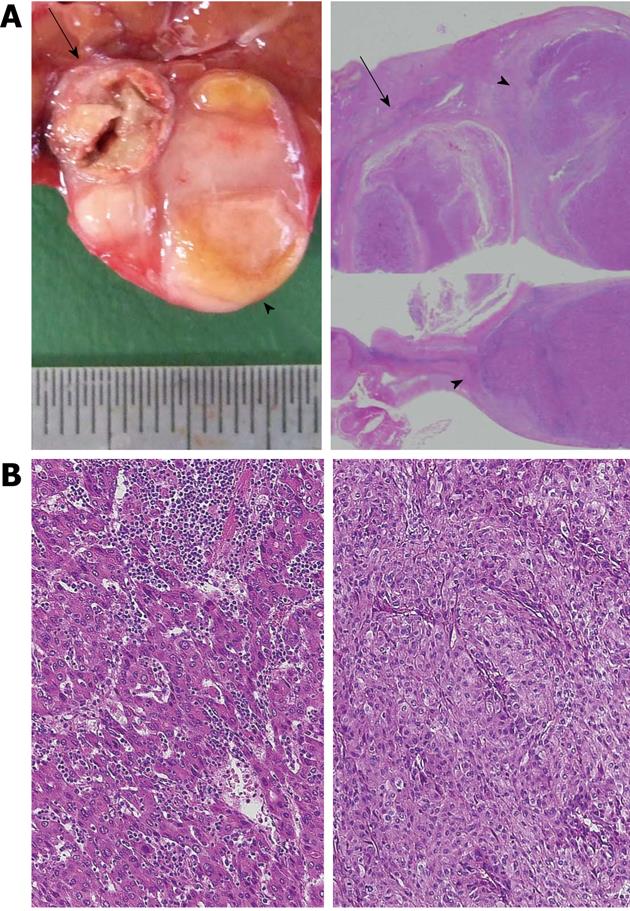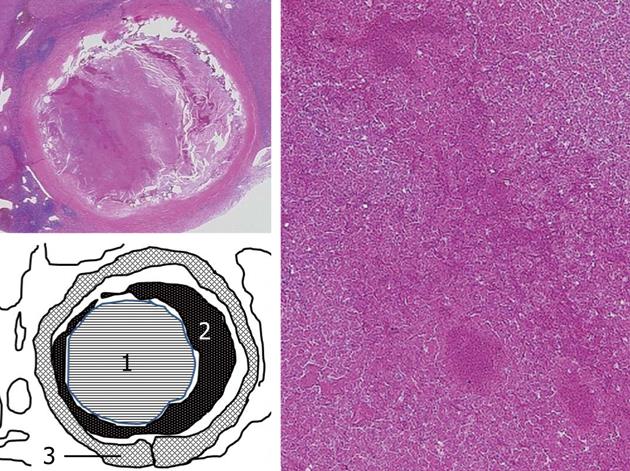Copyright
©2013 Baishideng Publishing Group Co.
World J Gastroenterol. Jan 7, 2013; 19(1): 129-132
Published online Jan 7, 2013. doi: 10.3748/wjg.v19.i1.129
Published online Jan 7, 2013. doi: 10.3748/wjg.v19.i1.129
Figure 1 Findings of computed tomography.
Upper left, plain abdominal computed tomography (CT) taken at the initial diagnosis revealed a 1-cm low-density lesion without calcification in liver segment 4 (white arrow). A small low-density area found in the left lateral section was a liver cyst (black arrow); upper right, plain abdominal CT taken 6 mo after the initial diagnosis revealed that the lesion had a ring calcification and an adjacent 1.8-cm lesion (white arrowhead); lower left and right, abdominal CT taken 6 mo after the initial diagnosis in the early phase (lower left) after a bolus administration of intravenous contrast material showed enhancement of the newly appeared lesion and the delayed phase (lower right) showed that it was hypoattenuated.
Figure 2 Macroscopic findings of the resected specimen, calcified and non-calcified lesions.
A: Left, macroscopic examination showed a 10-mm tumor with ring calcification (arrow) and an 18-mm tumor (arrowhead) existing side-by-side and encapsulated within the same thick fibrous tissue; Right, a prepared specimen (loupe image, hematoxylin and eosin staining); B: Left, microscopic examination findings of the calcified lesion showed the poorly differentiated hepatocellular carcinoma (hematoxylin and eosin staining; original magnification, × 200); Right, microscopic examination findings of the non-calcified lesion showed moderately differentiated hepatocellular carcinoma (hematoxylin and eosin staining; original magnification, × 200).
Figure 3 Schematic image of the structure of the calcified lesion.
Upper left, loupe image of the calcified lesion (hematoxylin and eosin staining; original magnification, × 5); Right, microscopic findings of the calcified lesion showed that necrotic area was extensively observed in the tumor (hematoxylin and eosin staining; original magnification, × 40); Lower left, schematic of the structure of the calcified lesion. A poorly differentiated tumor, in which spotty necrosis and hemorrhagic necrosis were extensively observed, was surrounded by a fibrous capsule. Calcification was identified between the tumor and the fibrous capsule (1: Poorly differentiated tumor; 2: Calcification; 3: Fibrous capsule).
- Citation: Murakami T, Morioka D, Takakura H, Miura Y, Togo S. Small hepatocellular carcinoma with ring calcification: A case report and literature review. World J Gastroenterol 2013; 19(1): 129-132
- URL: https://www.wjgnet.com/1007-9327/full/v19/i1/129.htm
- DOI: https://dx.doi.org/10.3748/wjg.v19.i1.129











